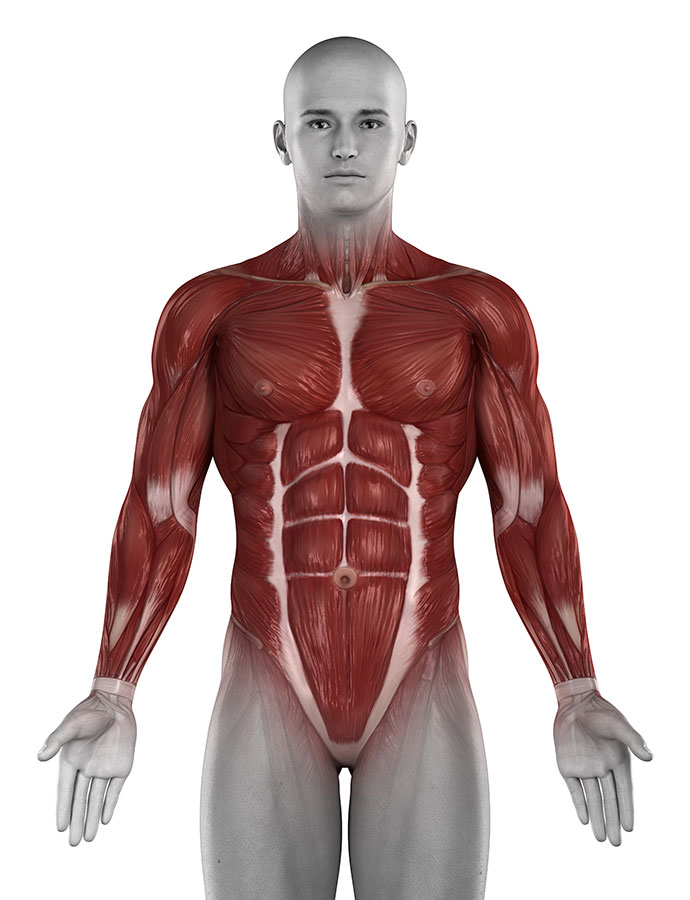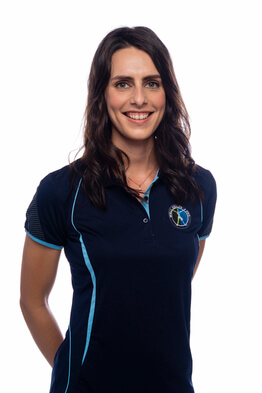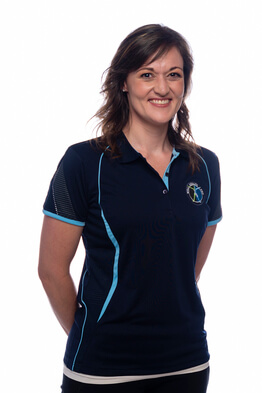Movement is one thing we all do on a daily basis. It is involved in all our work and leisure activities and life would be pretty ordinary if we could not move. The system that allows us to move is our wonderful muscular system. Our muscles attach to the bones of our skeleton. By shortening and lengthening the muscle fibers, we can control our body in 360 degrees. However, our muscular system doesn’t only make movement possible. By giving our stability muscle groups constant contraction, they provide us with a stabile base from which our other movements can function properly.
Another great thing about the muscular system, is that it is a system that we have a lot of control over. It can make significant changes in function, to give us better movement, control and a generally healthy feeling. We can exercise our muscles to improve strength, endurance, control and yes, to increase the size and shape as well!
Athletes use muscle strengthening to improve their performance. Similarly, we as physiotherapists use muscle strengthening to improve normal joint control and movement dysfunction. It is important in maintaining good posture and vital for you to move in a pain free way.
So, what does muscle strengthening mean?
Our muscles can become weak due to a number of reasons. It is mostly due to the muscle not being used correctly or when it is loaded too much and brings about weakness. This can happen after an injury, where the body was immobilized, or from not using the muscle correctly for a long period of time.
Muscle strengthening exercises are then used on specific muscles or muscle groups to improve function, strength and size. Afterwards you will be able to perform your task easily and correctly. When we talk about strengthening, we have to work (or load) the muscle to a higher level than is currently possible. This principle is known as overload and is essential in increasing strength and function. If we do not overload the muscle, then no strengthening occurs!
Why we always bring in muscle strengthening
Movement of a joint happens in a very coordinated and controlled way. It involves a number of different muscles working together. If there is a weakness in one of the muscles, it can create abnormal ways in which the joint moves. This can put pressure on the surrounding ligaments and tendons which tries to control the abnormal movement. There may also be excess pressure on the joint itself, and can lead to other muscles getting strained because of overcompensation.
All these factors can lead to inflammation and pain, due to the stress caused by the abnormal muscle and the compensation that occurs. As physiotherapists, it is our role to identify the muscle weakness and to strengthen it appropriately. This is done in conjunction with correcting the other imbalances that have occurred in the other muscles as well as addressing any stiffness or laxity in a joint. The goal of rehabilitation, and especially muscle strengthening, is to get the muscles to work efficiently with all the surrounding muscles to create smooth and controlled joint movement, pain-free.
Why is muscular strengthening beneficial?
- Improve joint control
- Facilitate correct muscle activation and sequencing
- Increase muscle fiber size
- Stimulate blood flow
- Promote cellular metabolism
- Enhance nerve control of the muscle
- Increase tissue flexibility
- Decrease muscle spasm
- Stimulate effective muscle contraction
“Life doesn’t get easier or more forging,
We get stronger and more resilient.”
The techniques used in muscle strengthening
Physiotherapists are movement and muscle specialists. Muscle strengthening and muscle endurance exercises form the cornerstone of our rehabilitation process. Just having pain and inflammation control treatment is not enough to return to normal, our aim is to correct how you move daily and prevent the future problems. This is why physiotherapists use a wide array of techniques, to guide forces along the most efficient lines. To unload, offload, stabilize or gain power.
There is a wide variety of ways that we include muscle strengthening activities in a rehabilitation program. This depends on how weak your muscles has become. Muscle strength is usually graded on a scale of 1 to 5 according to how well the contraction occurs:
First Grade: Visible or palpable muscle contraction but no movement
Second Grade: Movement with gravity eliminated
Third Grade: Movement against gravity
Fourth Grade: Movement against gravity with some resistance
Fifth Grade: Movement against gravity with full resistance
Different types of muscular strengthening approaches
To determine which technique is best suited for rehabilitation, we have to know what the muscle can generate on its own. There are also different types of muscle contractions and each type has its own characteristics and levels of difficulty. In general we use three types of muscle strengthening contractions in a physiotherapy setting. This includes:
- Concentric muscle contraction: There is a build up of muscle contraction as the muscle fibres slide over each other and the muscle shortens. This brings the bones that are moving closer together. An example would be if you bring your hand to your shoulder.
- Eccentric muscle contraction: Again, there is a build up of muscle contraction and the fibres are sliding over each other. However, in this type of contraction, the movement is in the opposite direction and the bones move further apart. Imagine holding a weight and slowly straightening your elbow to place it down. The slow controlled downward movement is an eccentric contraction.
- Isometric contraction: A build up of muscle contraction and tension in the muscle, but there is no sliding of fibres and there is no movement of the joint. It is contraction without movement and is important in creating joint stability. You can feel it if you just pull your tummy muscles tight. No movement has occurred, but there is still a contraction.
Different types of contractions
In general, it is easiest to start with isometric contractions, the eccentric strengthening and to follow through by using concentric muscle strengthening activities. Your therapist will guide you through the process depending on the muscle strength assessed, as well as what specific activity we need your muscle to do.
These types of muscle contractions are then incorporated into your therapy session and forms part of your home program as well. Your therapist can then use a variety of techniques to produce the required muscle strengthening contractions:
- Provide stimulation techniques to a very weak muscle to initiate a contraction. This can be done with electrical stimulation or hands-on techniques.
- Active assisted Muscle strengthening. This occurs when the muscle can generate some tension, but is not strong enough to move in full range on its own. Our therapist then helps the movement along while your trying to do the movement.
- Manual resistance techniques. This is where the therapist provides resistance to the muscle by using their hands to guide the movement. They can then vary the resistance as required by your muscle.
- Body weight and position to strengthen your muscle, like strengthening the quadriceps muscle by using a step to do step-ups, squats and lunges.
- Resistance equipment such as elastic bands and weights to load the muscle appropriately.
Anatomical Changes you’ll notice
Muscles are made up of individual muscle fibers that are grouped together to form muscle bundles. Now, when we strengthen a muscle, we place more strain on the muscle compared to what it is used to. When a muscle grows, it is known as hypertrophy and it occurs due to an increase in structural proteins in the muscle fibers, as the body starts to adapt to the increased demand placed on them. The muscle adapts quite rapidly to meet the demand.
When a muscle is not loaded at its upper limit, you’re not gaining strength. This is why where most patient fail at full recovery. Not knowing the limits to which the tissue can still handle the load, or avoiding movement altogether.
There is no creation of new muscle cells, merely an adaption occurs within the current muscle cell and fibers that increase their overall muscle size. This is also why athletes follow a high protein diet and make use of certain supplements or protein shakes. To build and grow their muscles. After all, it is protein that forms the building blocks for the increased muscle size. It still doesn’t mean their ‘strong’.
Changes on a cellular level:
When talking about muscle strengthening, we are focused more on the fast twitch fibers in our body. These fibers produce short, powerful movements that cannot be repeated for an long time. The other fibers we have are the slow twitch fibers which do not generate as much force, or work as quickly, but can repeat the action over a long period of time. Both types of fiber are engaged when we work with muscle endurance activities.
When a muscle is pushed beyond its current capacity, we start to create microtrauma on a cellular level to the muscle fibers. It is the small microtears that give us a feeling of soreness or stiffness after a muscle strengthening session. This is then repaired by the body, and the extra structural protein to replace or repair the older tissues results in the increase in muscle size. As the demands on the muscle are increased, the body needs to provide more oxygen to the cells as well as remove some of the waste products. This results in better blood supply to the exercised muscle group. The cells then use the oxygen and nutrients more efficiently, making the muscle function more effective. At the same time, the nerves signal to the muscle is enhanced, and more muscle fibers can be engaged during a single contraction.
What should I feel during and after muscle strengthening?
A feeling of strain in the muscle should be felt during the movement, seeing as the muscle is forced to work harder than it has previously done. The muscle should contract smoothly throughout the entire movement. If you cannot maintain the full control and contraction throughout the movement, then the weight may be too heavy for the muscle at this point. Remember, during strengthening, we use fast twitch fibers that produce a strong contraction, but can only be reproduced for a small amount of repetitions. There should be no pain during the strengthening process, as pain can inhibit proper muscle contractions. However you should find it difficult, and feel tension in the muscle being generated. A feeling of tiredness and exercise soreness should be felt in the muscle after a session. You had a good workout after all!
On the next day you may feel some muscle soreness as the body starts the process of healing and muscle growth. This is commonly referred to as DOMS – Delayed Onset Muscle Soreness.
How long does a muscle strengthening treatment take?
This depends purely on the condition of the muscle. For very weak muscles (Gr.1-3), the session can be very short with small sets and repetitions done to get effective muscle contraction. If the contraction is too poor , we recruit the surrounding muscles , and get an overflow effect. The stronger muscle groups could have longer workouts depending on their current condition. Typically, muscle strengthening can last anything between 5 minutes to 30 minutes in a session.
However, muscle strengthening rehabilitation will only be a part of your treatment session. Your physiotherapist will often combine it with soft tissue techniques, joint mobilization, taping or electrical therapy to produce well rounded benefits that are incorporated into a functional program, designed just for you.
How many times should I go for muscle strengthening?
You should feel the effect of the strengthening after the first session, with some muscle soreness on the next day. As we are working hard to create muscle growth (Hypertrophy), we want some recovery time in between sessions. Often, you will need to come at least twice a week for the first 2 to 3 weeks. Your physiotherapist will discuss a treatment plan with you after they have done a full assessment. We’ll give you an idea of how long it will take for your condition to improve as well as how often you’ll need treatment. In some cases we’ll need 6-12 sessions.
What can I do at home to ensure muscle strengthening is effective?
Muscle strengthening is hard work, but rest is often just as important as the exercise itself. It is important that you follow the guidelines given to you by your therapist, as they are designed specifically for you and your condition. Over-training can lead to more injuries, and can actually slow down your recovery period. Remember, too little exercise will not build your muscle, but too much strain can injury it. Trust your physio, we are the experts in guided strengthening and rehabilitation. This is the best way to get long-lasting pain relief.
There are a few things you can do at home:
- Stretch the muscles being trained – as a muscle grows, it can get stiff. Stretching helps decrease post exercise soreness.
- Use heat/ice as directed by your physio.
- Incorporate your home program into your daily activities. Consistency is key in achieving your goals.
- Listen to your body – it is a good doctor. We want to load the muscle correctly, not overwork it to injury. Or even worse, avoid using it at all.
Cost of muscle strengthening rehabilitation
Muscular strengthening and muscular endurance exercises are never done alone. They are complimented with other physical therapy modalities to help correct an underlying problem. Most medical aids cover the muscle strengthening part of the rehabilitation process.
Medical Aid Code – 501
The muscle strengthening treatment code 501 is used when we use strengthening training with all our rehabilitation. However, strengthening is never done as a sole modality and will always be combined as part of an extensive exercise and treatment program.
Is it essential to have an experienced physiotherapist to assist in your muscle strengthening rehabilitation?
When it comes to strengthening, there are many supposed “expert trainers” that are found on the internet, and YouTube. They may have some experience in general muscular conditioning, but only physiotherapists can integrate strengthening in a structured and specific program, to assist in your recovery for your specific problem. Function and correct movements are vital, and your physiotherapist has an in-depth knowledge on how your muscular system works. Plus, they also understand the pathology and bio-mechanics of what is causing your particular problem. A DIY approach may leave you frustrated and annoyed, rather do it right first time around.
Our physiotherapists have years of clinical experience and are the movement and musculo-skeletal experts in the medical field. Rehabilitation is always tailored to be specific, accurate and targeted.





